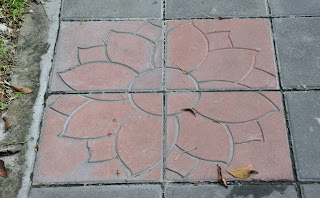
No account of Brickfields will be complete without mention of the Buddhist Temple here. The temple or Vihara celebrated its 100th anniversary in 1995, which makes it 114 years old now.
The Centenary Celebration booklet mentions that the Sasana Abhiwurdhi Wardana Society was born out of hardship, perseverance and confidence to make it what it is today.
In the late 19th century a group of 87 Sinhalese applied to the then British Resident, W H Treacher to grant them a parcel of land to build a temple to practice their faith and to bring down from Ceylon a number of monks for the propagation of Buddhism.
When the lotus flower is depicted on the pavements and street lights, you know that you are on the right track to the Buddhist Maha Vihara.

The lotus fountain welcomes all devotees and visitors as we go through the main entrance.

The Shrine Hall is currently undergoing renovations.

This looks like an Ashoka Pillar.
Ashoka ascended to the throne in 269 BCE inheriting the empire founded by his grandfather Chandragupta Maurya. Ashoka was reputedly a tyrant at the outset of his reign. Eight years after his accession he campaigned in Kalinga where in his own words, "a hundred and fifty thousand people were deported, a hundred thousand were killed and as many as that perished..." After this event Ashoka converted to Buddhism in remorse for the loss of life. Buddhism didn't become a state religion but with Ashoka's support it spread rapidly. The inscriptions on the pillars described edicts about morality based on Buddhist tenets. Legend has it that Ashoka built 84,000 Stupas commemorating the events and relics of Buddha's life. Some of these Stupas contained networks of walls containing the hub spokes and rim of a wheel, while others contained interior walls in a swastika shape. The wheel represents the sun, time, and Buddhist law (the wheel of law, or dharmachakra), while the swastika stands for the cosmic dance around a fixed center and guards against evil.
(Wikipedia)
The inscriptions on the pillar.

While generally, this temple complex has a lot of Sinhala influence, other cultures also seem to play a part here like this Chinese lion.

The International Pagoda.

Some religions service is taking place inside of the Pagoda.

Tun Tan Siew Sin, was also the president of the MCA (Malaysian Chinese Association) then. He is the son of Tun Tan Cheng Lock, founder of MCA.

The temple is not only about the spiritual well-being of devotees but also about providing education for their worldly well-being.

And so ends my walk around the Brickfields area.
































1 comment:
DATUK YIP KUM FOOK (MCA GOMBAK) GUNA POLITIK DALAM BUDDHIS KUIL
KEPADA SESIAPA YANG BERKENAAN
Teras Buddha Dhamma tidak ditujukan kepada penciptaan institusi politik yang baru dan mewujudkan perkiraan politik. Pada asasnya, ia bertujuan untuk mendekati masalah-masalah masyarakat dengan memulihkan individu yang membentuk masyarakat tersebut dan dengan mencadangkan beberapa prinsip am yang melalui mana masyarakat boleh dipandu ke arah kemanusiaan yang lebih besar, baik kebajikan ahli-ahlinya, dan perkongsian sumber yang lebih saksama.
Sebaliknya, mungkin Datuk Yip Kum Fook bapa punnya Buddha kerana dia boleh memainkan politik kotor di dalam Kuil Buddha (SANMAK SAMBODHI) di No: 19-21 Jalan 38 Taman Desa Jaya, Kepong 52100 Kuala Lumpur, Malaysia. Jika Buddha hidup, Buddha akan menjerit kepada bapanya kerana pengetahuan yang sangat rendah ini. MENGAPA orang di bahawa Kuil Buddha adalah sangat bodoh untuk manusia yang digunakan oleh sesetengah pemimpin yang dipilih.
Walau bagaimanapun, ini tidak bermakna bahawa penganut agama Buddha tidak boleh atau tidak harus terlibat dalam proses politik, yang merupakan realiti sosial. Kehidupan anggota masyarakat yang dibentuk oleh undang-undang dan peraturan, pengaturan ekonomi yang dibenarkan di dalam sesebuah negara, pengaturan keinstitusian, yang dipengaruhi oleh perkiraan politik masyarakat itu. Namun begitu, jika seorang penganut Buddha ingin terlibat dalam politik, beliau (Datuk Yip Kum Fook, MCA Gombak) tidak harus menyalahgunakan agama untuk mendapatkan kuasa politik, tidak baik bagi orang-orang yang telah melepaskan kehidupan duniawi untuk memimpin tulen, kehidupan beragama terlibat secara aktif dalam politik.
BUDDHIST MAHA VIHARA
Brickfields, KL.
Post a Comment